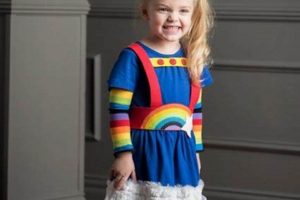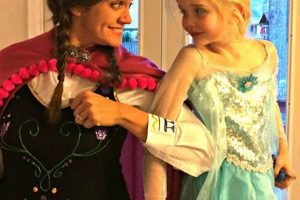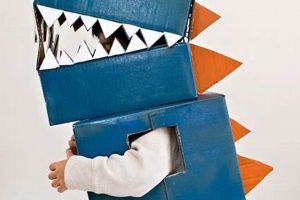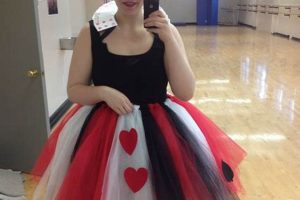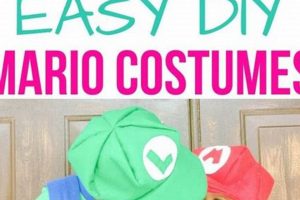The construction of terrifying homemade clown outfits allows individuals to personally craft menacing characters for various occasions. These ensembles typically involve a combination of repurposed garments, theatrical makeup, and fabricated accessories intended to evoke fear or unease. An example includes the modification of a brightly colored jumpsuit with simulated bloodstains and the application of exaggerated, grotesque facial features.
The creation of these custom costumes offers advantages such as cost-effectiveness, personalization, and creative expression. Compared to commercially produced alternatives, the do-it-yourself approach enables significant savings. Historically, the concept of malevolent clowns has evolved through literature and film, influencing the design and reception of such attire, and allowing an expressive outlet for engagement with these themes.
The subsequent sections will explore specific techniques for achieving different levels of horrifying realism. The focus will be on makeup application, garment alteration, and the construction of effective props. This encompasses strategies for creating convincing lacerations, distressing clothing, and developing unique elements for an individualized terrifying persona.
Creating a Terrifying Clown Persona
The following guidelines provide a framework for developing a frightening clown character. Adherence to these suggestions will enhance the overall impact of the costume and contribute to a more convincing presentation.
Tip 1: Invest in High-Quality Makeup: Substandard makeup can smear, fade, or cause skin irritation. Opt for professional-grade face paints designed for theatrical use. Apply a white base layer evenly before adding details.
Tip 2: Emphasize Exaggerated Features: Expand the size and shape of the mouth, eyes, and eyebrows with dramatic makeup. This contributes to a grotesque and unsettling appearance.
Tip 3: Distort the Clown’s Smile: Instead of a cheerful grin, create a sinister or maniacal expression. Extend the corners of the mouth upwards at an unnatural angle or use prosthetics for a more permanent effect.
Tip 4: Utilize Contrasting Colors: Employ a combination of vibrant and dark colors to create visual tension. Red, black, and white are classic choices, but consider adding unexpected hues such as purple or green for added impact.
Tip 5: Add Realistic Blood Effects: Use fake blood sparingly and strategically. Concentrate blood around the mouth, eyes, and any fabricated wounds. Experiment with different consistencies of fake blood for varying effects.
Tip 6: Modify Existing Garments: Rather than purchasing a new costume, repurpose old clothing. Rip, tear, and stain the fabric to create a distressed and menacing appearance. Avoid pristine or overly polished materials.
Tip 7: Accessorize with Unsettling Props: Carry items such as a rusty hammer, a stained teddy bear, or a collection of sharpened tools. These props enhance the character’s backstory and contribute to a sense of unease.
Tip 8: Develop a Unique Backstory: Consider the character’s motivations, history, and personality. A well-defined backstory will inform performance and add depth to the overall presentation.
Implementing these techniques elevates the overall execution. Attention to detail in makeup, wardrobe, and accessories, when coupled with a developed backstory, generates a truly disturbing and memorable impression.
The subsequent sections will provide guidance on selecting appropriate makeup products, sourcing affordable costume elements, and refining the overall character concept. The final result will be a killer clown costume with a terrifying individuality.
1. Makeup Application
Makeup application is integral to the creation of a terrifying clown persona, functioning as a primary means of transforming an individual into a figure of fear. The effect of a poorly executed makeup design negatively impacts the overall impact of the costume, mitigating the desired sense of horror. In contrast, skilled application techniques enable the creation of exaggerated features, grotesque expressions, and convincing blood effects, augmenting the costume’s effectiveness. For example, the meticulous application of pale white face paint, coupled with exaggerated, darkly outlined eyes and a menacing red smile, can instantly transform an ordinary individual into a frightening clown character. The mastery of makeup application is therefore crucial for achieving a truly disturbing and memorable villain.
Specific techniques, such as contouring and highlighting, further enhance the dimensionality of the character’s face, accentuating sinister aspects. The application of prosthetic pieces, such as scars or horns, necessitates careful blending with the surrounding skin, requiring skill and precision. Moreover, understanding the properties of different makeup products, including their longevity and resistance to smudging, is essential for maintaining the integrity of the design throughout the event or performance. Incorrect product selection or application can result in a diluted or unintentionally comical appearance, undermining the overall effort.
Ultimately, proficient makeup application serves as a cornerstone for the construction of a successful terrifying clown. The ability to skillfully manipulate facial features, create visual illusions, and employ appropriate products is paramount. While elaborate costuming and props contribute to the overall effect, it is the face that often dictates the character’s perceived malevolence. Recognizing this importance ensures emphasis on this skill during the costume construction process, contributing to a more impactful and credible result.
2. Garment Alteration
Garment alteration is a pivotal component in the development of terrifying homemade clown costumes. The modification of existing clothing items allows for the creation of a unique and unsettling aesthetic, often surpassing the impact of store-bought alternatives. The deliberate damage and restructuring of garments can evoke a sense of decay, neglect, and inherent threat. For instance, a brightly colored clown suit, deliberately ripped and stained, presents a visual contradiction that contributes to the overall unsettling effect. The alteration process allows for a high degree of customization, enabling the creator to realize a specific character concept and tailor the costume to their individual physique. The strategic tearing, fraying, and re-stitching of fabrics communicate a deliberate intent to disturb and unsettle, a critical element in achieving the desired effect.
Consider the practical applications of these alterations. Applying uneven, hand-stitched patches to a clown outfit implies a history of repair, but also a lack of care, enhancing the character’s unkempt and potential
ly dangerous nature. Subtly altering the silhouette of garments, such as elongating sleeves or widening collars, creates a sense of distortion that contributes to the overall unsettling impression. The addition of grotesque embellishments, such as faux bloodstains or repurposed buttons, further intensifies the costume’s macabre appeal. Moreover, the choice of materials plays a crucial role; opting for heavier fabrics like canvas or denim lends a more robust and menacing presence compared to lighter, more whimsical materials. Such selection also offers greater durability through the distressing and modification process.
In summary, garment alteration is a vital component, as customization and expression are key to the art of DIY killer clown costumes. The modifications detailed above have a significant impact on the overall result, conveying the narrative elements of terror. This approach also provides creative freedom, giving enthusiasts the tools to create a unique and impactful horror experience. Ignoring this stage risks resulting in a less impactful and generic costume.
3. Prop Construction
The construction of props significantly elevates the impact of a homemade terrifying clown costume. These implements serve as extensions of the character, communicating unspoken aspects of their personality and intent. A meticulously crafted prop transforms a basic costume into a narrative element, providing context and enhancing the perceived threat. For instance, a seemingly innocuous child’s toy, modified to appear menacing, presents a disturbing juxtaposition. The success of this component relies on careful consideration of materials, construction techniques, and the overall aesthetic of the chosen prop. Neglecting this aspect diminishes the costume’s potential to generate fear or unease; conversely, well-executed prop construction enhances the final result.
Practical application reveals several effective prop strategies. A rusted hammer, smeared with simulated blood, suggests violence and malice. Balloons, deflated and bearing cryptic messages, introduce an element of psychological discomfort. Confectionery items, such as lollipops, can be made unsettling by piercing them with needles or covering them in a viscous substance. The selection of props should align with the character’s backstory and intended actions, contributing to a cohesive and credible presentation. Furthermore, safety should be a paramount consideration; sharp or heavy props necessitate careful handling to avoid accidental injury.
In conclusion, prop construction is integral to achieving a high level of effectiveness in homemade terrifying clown costume design. Through strategic selection and execution, props amplify the costume’s narrative potential, communicate character nuances, and intensify the overall sense of unease. While the construction of props can be challenging, the effect enhances the result of the creation and makes it all the more terrifying.
4. Character Backstory
A character’s backstory functions as the foundation upon which the entire killer clown persona is built, significantly influencing the costume’s design and the individual’s performance. Without a well-defined history, the costume risks appearing superficial and lacking in psychological depth. The backstory dictates the clown’s motivations, personality quirks, and relationship to violence, directly impacting the design choices made in garment alteration, makeup application, and prop selection. For example, a clown with a history of childhood trauma might exhibit costume elements reflecting that pain, such as a torn and dirty costume, smeared makeup suggesting perpetual tears, and props like broken toys. The backstory provides the “why” behind the “what,” lending authenticity and menace to the overall presentation.
Consider the practical application of this principle. A clown whose backstory involves a history of failed magic tricks could incorporate props related to these failed performances, such as a broken wand or a deck of cards with missing suits. The backstory can also justify specific makeup choices, such as deliberately uneven application to suggest mental instability, or the use of specific colors to symbolize past events. The performance style, too, is directly informed by the backstory. A clown with a history of betrayal might display a hesitant demeanor, punctuated by sudden outbursts of anger, while a clown driven by revenge might exhibit a cold, calculating presence. The deeper the backstory, the more nuanced and believable the character becomes, enhancing the overall unsettling effect.
In summary, character backstory is an indispensable element in the creation of a DIY killer clown costume. It transforms a mere visual representation into a fully realized character, imbuing the costume with depth, meaning, and a palpable sense of menace. Overlooking this aspect relegates the costume to a generic and ultimately less impactful representation of horror. Developing a well-considered backstory serves as a guide for every design decision, resulting in a cohesive, terrifying, and psychologically compelling persona. This deep, psychological connection is the difference between a generic scary outfit, and a truly terrifying and memorable killer clown.
5. Horror Elements
The successful execution of a homemade terrifying clown costume hinges critically on the effective incorporation of various horror elements. These elements, functioning as building blocks of fear, transform a potentially whimsical character into a figure of genuine dread. Their absence results in a costume that lacks the necessary impact to elicit a strong emotional response; conversely, their strategic inclusion amplifies the unsettling qualities inherent in the clown archetype. For instance, the addition of sharp, jagged teeth to the clown’s smile, either through makeup or prosthetics, immediately signals danger and aggression. The practical significance of understanding these horror elements lies in the ability to create a truly frightening and memorable persona, rather than a merely comical one.
Further analysis reveals that these elements often operate on multiple levels, appealing to both conscious and subconscious fears. The use of contrasting colors, such as bright red against stark white, creates visual tension and unease. Distorted proportions, whether in the makeup or the costume itself, challenge conventional notions of normalcy and beauty, triggering a sense of discomfort. The incorporation of symbols associated with death or decay, such as simulated blood or skeletal motifs, directly confronts mortality and reinforces the costume’s malevolent nature. The effective integration of these elements necessitates a thoughtful and deliberate approach, rather than a haphazard accumulation of scary imagery.
In conclusion, the deliberate application of horror elements is paramount in the creation of a truly terrifying killer clown costume. These elements transform a potentially benign character into a harbinger of fear, ensuring the costume achieves its intended effect. The challenge lies in achieving a balance between overt aggression and subtle psychological manipulation, creating a persona that is both visually disturbing and deeply unsettling. Mastery of these component
s creates an experience that goes beyond the superficial, tapping into deep-seated fears and leaving a lasting impression.
6. Performance Style
Performance style is an integral element in realizing the full potential of a killer clown costume. The costume itself provides the visual foundation, but the performance style determines how that foundation is interpreted and experienced by an audience. It transforms a static image into a dynamic and potentially terrifying presence.
- Vocal Delivery
The clown’s voice is a critical component of the performance. A high-pitched, manic giggle can be as unsettling as a guttural growl. The use of silence, punctuated by sudden, jarring noises, can create tension and anticipation. The voice should align with the clown’s backstory and motivations. A clown driven by revenge might speak in a measured, deliberate tone, while a clown suffering from mental instability might exhibit erratic and unpredictable vocal patterns. The conscious manipulation of vocal tone, volume, and cadence is essential for enhancing the costume’s impact.
- Physicality and Movement
The way a clown moves directly affects the perceived level of threat. Exaggerated, jerky movements can convey a sense of instability or aggression. Slow, deliberate movements can create a feeling of unease and anticipation. The use of space is also important; invading personal space can be highly unsettling, while maintaining a distance can create a sense of mystery and menace. The clown’s gait, posture, and gestures should be carefully considered to reinforce the desired impression. A lumbering, unbalanced gait can suggest physical deformity or mental instability, while precise, controlled movements can indicate a calculating and predatory nature.
- Interaction with the Audience
The manner in which the clown interacts with an audience significantly contributes to the overall experience. Direct eye contact, prolonged and unwavering, can be deeply unsettling. Mimicking the audience’s movements can create a sense of unease and paranoia. The use of seemingly innocent gestures, such as offering a flower or a balloon, followed by a sudden act of aggression, can be particularly effective. The clown’s interaction should be unpredictable and disorienting, blurring the lines between reality and performance. A successful interaction relies on careful observation of the audience’s reactions and a willingness to adapt the performance accordingly.
- Use of Props in Performance
Props are not merely decorative elements; they are extensions of the clown’s performance and should be integrated seamlessly into their actions. A hammer, for example, can be used to threaten, to create unsettling sounds, or even to perform macabre “magic tricks.” Balloons can be manipulated to create a sense of vulnerability and then suddenly popped to startle the audience. The way a prop is handledthe speed, the force, the contextcontributes significantly to its impact. A clown who cradles a teddy bear one moment and then violently destroys it the next creates a jarring contrast that heightens the sense of unease.
These elements, when combined with a well-designed costume and a compelling backstory, elevate the killer clown from a simple visual representation to a fully realized character. The performance style is the key to unlocking the costume’s potential and transforming it into a truly terrifying experience. It is the final step in bringing the killer clown to life.
Frequently Asked Questions
The following questions address common concerns and misconceptions surrounding the creation of homemade terrifying clown costumes. Information is provided to clarify design choices, safety considerations, and ethical implications.
Question 1: What constitutes an ethically responsible approach to designing such a costume?
Responsible design prioritizes respect for public safety and avoids elements that could incite fear or panic in vulnerable individuals, such as children or those with pre-existing phobias. The intent should be creative expression, not malicious harassment.
Question 2: How does one minimize the risk of misinterpretation or negative reactions from the public?
Context is critical. Wearing the costume at appropriate events, such as Halloween parties or theatrical performances, mitigates the risk of misinterpretation. It’s important to avoid wearing such costumes in public spaces where it may cause undue alarm.
Question 3: What are the essential safety precautions to observe when using makeup and prosthetics?
Always conduct a patch test to check for allergic reactions. Use non-toxic, hypoallergenic products. Ensure proper ventilation during application and removal. Follow manufacturer instructions carefully.
Question 4: How can potentially dangerous props be safely incorporated into the costume design?
Simulated weapons should be clearly distinguishable from real weapons. Sharp edges must be dulled or covered. Avoid any prop that could be easily mistaken for a functional weapon by law enforcement or the public.
Question 5: What legal considerations are relevant to wearing a potentially frightening costume in public?
Local ordinances regarding masks, public disturbance, and brandishing imitation weapons vary widely. Familiarize yourself with applicable laws in the relevant jurisdiction before wearing the costume in public.
Question 6: How can the creator of a terrifying clown costume ensure that their performance remains within ethical boundaries?
The performance should avoid any actions that could be interpreted as threatening, harassing, or discriminatory. Respect personal boundaries and refrain from engaging in behavior that could cause distress or alarm. The goal is to entertain, not to terrorize.
In summary, careful planning, responsible execution, and adherence to ethical guidelines are crucial for the creation and use of a terrifying clown costume. The emphasis should remain on artistic expression and entertainment, while minimizing the potential for harm or distress.
The following section will delve into strategies for refining the overall presentation and maximizing the costume’s impact.
Conclusion
This exploration has detailed critical elements in the creation of terrifying homemade clown costumes. These encompass makeup application techniques, garment alteration strategies, prop construction methods, the development of compelling character backstories, and strategic incorporation of horror elements, and, finally, compelling performance styles. These components collectively determine the overall impact and effectiveness of the final product.
The success of such an endeavor rests on meticulous planning, responsible execution, and a thorough understanding of horror aesthetics. Future innovations may involve the integration of advanced technology, such as animatronics or augmented reality, further blurring the line between costume and reality. Ultimately, the creation of a genuinely terrifying clown costume is an exercise in artistic expression and psychological manipulation, requiring a blend of creativity, technical skill, and a deep understanding of human fears.


